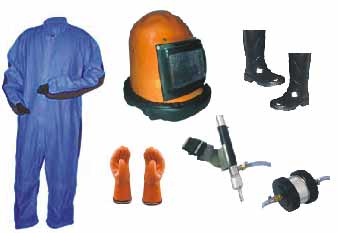
For an effective sandblasting work, it has become mandatory to know about sand blasting machine’s equipment and its operation processes. If you are an owner of a company or your job profile is related to sand blasting work, you must read this article. In this article we are going to cover almost all the details related to sand blasting machine equipment and its work processes.But before we describe about it let me also tell you something more about it.
Sand blasting is also called as Abrasive blasting. It is the operation of forcibly propelling a stream of abrasive material against a surface under high pressure to smooth a rough surface, roughen a smooth surface and shape a surface or to remove the surface contaminants. There are several variants of it’s process, such as bead blasting, sand blasting, shot blasting and soda blasting etc.
Abrasive blasting is a method of propelling abrasive using a compressed gas or pressurized liquid as the propellant. There are numerous generic terms for this application usually related to the abrasive media used. General terms include sand blasting,shot blasting, bead blasting and soda blasting.
Portable Blast Equipment: Dry abrasive blasting applications are powered by a diesel air compressor. Most applications involve a pressurized vessel that contains the abrasive and meters it into the compressed air stream. Wet blasting is accomplished by injecting the abrasive into a pressurized water stream or creating slurry of abrasive and water that is pressurized or introduced into a compressed air stream.
Automated Blasting: It is an automated blasting that provides surface preparation and coating applications under cover to minimize the effects nature can have on prepared steel, with minimum or no impact on the environment.

Blast Cabinet: A typical blast cabinet consists of four components; the containment, the abrasive blasting system, the abrasive recycling system and the dust collection. Essentially it is a closed loop system by that an operator can blast the part and also recycle the abrasive. The operator blasts the parts from the outside of the cabinet by placing his arms in gloves attached to glove holes on the cabinet, viewing the part through a view window and, typically, turning the blast on and off using a foot pedal or treadle.
Two systems which is used in cabinet are dry and one is wet- A Siphon blast system uses the compressed air to create a vacuum in a chamber (also known as the blast gun). The negative pressure pulls abrasive into the blast gun where the compressed air directs the abrasive through a blast nozzle.
Typically these Sandblasting equipment consists of a chamber in which sand and air both get mixed. Nozzles come in a variety of shapes, sizes, and materials. Silicon carbide and boron carbide are more wear resistant and are for use with harder abrasives such as Aluminum oxide.
The abrasive is stored in the pressure vessel then sealed. It is metered into the blast hose and conveyed by the compressed gas through the blast nozzle. It is typically used to create a surface profile when the frictional heat of dry blasting would damage the part.
Wheel Blasting: Wheel machines are a high-power, high-efficiency blasting operation with recyclable abrasive. Specialized wheel blast machines propel plastic abrasive in a cryogenic chamber; this type of wheel blasting is usually used for deflating plastic and rubber components. The size of the wheel blast machine and the number and power of the wheels depends on the parts to be blasted and on the expected result and efficiency.

Hydro-Blasting: It is commonly known as water blasting, is a common abrasive blasting operation because it is very effective and, in most cases, will only require one operator. In this process water is used to remove old paint, chemicals, or buildup without damaging the previous surface. This method is ideal for cleaning internal and external surfaces because the operator is generally able to send the stream of water in places that previously were deemed unreachable.
Blast Room: it has three of the four components of a blast cabinet. Most blast rooms have recycling systems ranging from manual recycling to full reclaim floors that convey the abrasive pneumatically or mechanically to a device that cleans the abrasive prior to recycling.
Micro-Abrasive Blasting: Micro-abrasive blasting uses smaller nozzles to provide a fine stream of abrasive accurately to either a small part or a small area on a larger part. Mostly, the area to be blasted is from about 1 mm to only a few cm at most as abrasive blasters with larger nozzles are faster for larger areas.
Micro-abrasive blasting uses media with particle sizes from 10 micrometers up to about 150 micrometers and usually higher pressures than most of the larger blasters 40 psi to 150 pounds per square inch deliver sufficient energy to these small particles.
However, the equipment for abrasive blasting usually consists of but is not limited to a hand-held nozzle that directs a stream of abrasive particles. Therefore abrasive is mixed with air in a mixing chamber in order to transport it to the nozzle where it is subject to a high-velocity air stream that propels it towards the job.
